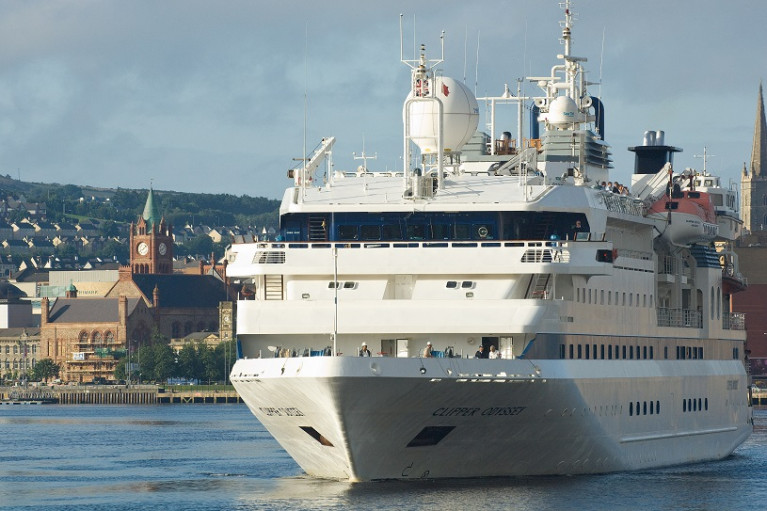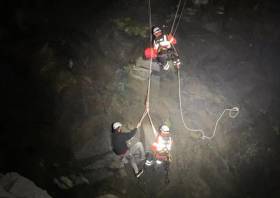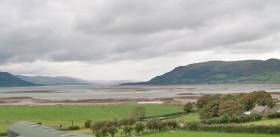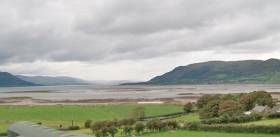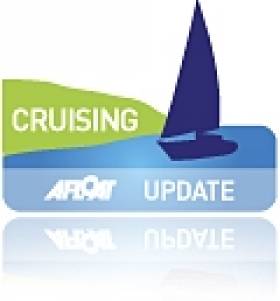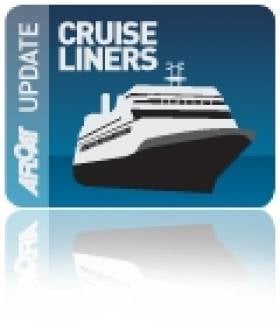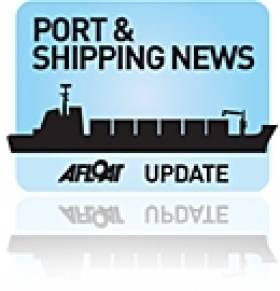Displaying items by tag: Greencastle
Plans to develop a multi-million euro deep water terminal for cruise ships at Greencastle (Co. Donegal), remain on course says the boss of Foyle Port, Brian McGrath.
According to the Derry Journal, Mr. McGrath said the port has estimated the massive infrastructure project is likely to cost between €30m and €50m.
Foyle Port had been ready to proceed with a detailed design for the new berthing facility just as the coronavirus pandemic arrived on these shores, Mr. McGrath told members of the Oireachtas Joint Committee on the Implementation of the Good Friday Agreement.
“We had identified Greencastle as a natural deep water harbour. It lends itself very naturally to exploiting our tourist productions on both sides of the border.
“So consistent with [Irish] government policy and Executive policy what we were trying to do was to look to plug the gap that exists in the north west,” he told TDs, senators and MPs.
Much more here on this cross border development.
Greencastle, Co Donegal’s Irish Coast Guard team were tasked by the IRCG emergency operations centre at Malin to a rock climber who got into difficulty at Hell’s Hole on Malin Head on Tuesday evening (28 May)
The climber was trapped 45 metres down the cliff in a dangerous location, the cliff face being unpredictable with loose rocks and particularly so during hours of darkness.
Despite these challenges, the coastguard cliff team successfully rescued the climber.
If you see someone in difficulty, on the cliffs, coast or water, do not hesitate to dial 112 or 999 and ask for the coastguard.
Legal Challenge To Carlingford Ferry Rejected
#FerryNews - A legal challenge against a new car ferry route across Carlingford Lough has been rejected, according to the News Letter.
The route across the narrowest part of the lough between Greencastle in Co Down and Greenore in Co Louth was given the go-ahead in the summer of 2015 against the objections of some local residents – some of whom took their case to Belfast High Court requesting a judicial review against Newry, Mourne and Down District Council.
However, a case by one litigant was this week dismissed by Justice Adrian Colton, who said: “There is simply no expert evidence which begins to challenge the conclusions of the various environmental impact assessments which were carried out throughout the entire process.”
The complainant, who lodged her appeal in May this year, had accused the council and Northern Ireland’s Department of Agriculture, Environment and Rural Affairs of a flawed consultation and assessment process ahead of work on a new ferry terminal near her home in Greencastle.
But the judge declared her argument over protections for marine wildlife in the lough was “misplaced as a matter of law” as the area is not a designated Special Area of Conservation.
The News Letter has more on the story HERE.
Legal Challenge Against Carlingford Ferry Terminal Plans
#FerryNews - A new car ferry route that aims to cut the distance between towns on opposite sides of Carlingford Lough from 32 miles to just one is facing a legal challenge from campaigners opposed to the building of a new terminal.
As previously reported on Afloat.ie, the ferry route across the narrowest part of the lough between Greencastle, Co Down and Greenore, Co Louth was given the go-ahead last summer despite the objections of local residents who argue that the project would "spoil the natural beauty" of the area.
According to the Belfast Telegraph, activists have now lodged papers in Belfast High Court requesting a judicial review against Newry, Mourne and Down District Council.
Among their claims is that permission to allow for piledriving in the lough's north shore for pontoons for the £7 million (€8.9 million) scheme was not properly given.
The Belfast Telegraph has more on the story HERE.
Sail Ireland's North–West Coast to Derry
#visitderry – Sail Ireland's North West and discover Donegal's rugged coastline and the River Foyle to the walled city of Derry~Londonderry, named by 'Lonely Planet' as one of the Top 10 Cities to visit in the World!
Follow the seaways from Scotland, England and Wales and, with good planning, the tidal streams will make light work of the passage across the North Channel and westward to the Foyle. Lying in wait is the fantastic coastline of Inishowen, with vistas of towering stacks, cliffs, beaches and a repertoire of heritage!
Sailing along the top of Ireland, take advantage of the sheltered delights of Lough Foyle and, at its mouth, the quaint village of Greencastle, the second-biggest fishing port in Donegal.
The harbour accommodates a wide range of yachts and a new permanent pontoon is planned for 2015. Trawlers from here ply as far as Rockall and the local mussel and oyster harvests supply restaurants across the region. Greencastle itself is home to a superb seafood eatery and its traditional Irish pubs are perfect places to relax and enjoy the 'craic' in this friendly village.
Visitors can also avail of a stunning shoreside walk and check out the Inishowen Maritime Museum – housed in the Coastguard buildings overlooking the harbour. Lough Foyle is shallow but a well-marked shipping channel runs all the way from Greencastle to Derry~ Londonderry's Foyle Marina, where two pontoons can berth up to 120 boats.
Named by acclaimed travel publication 'Lonely Planet' as a Top 10 City in the World, Derry is renowned as one of the finest walled cities in Europe and the defences celebrated their 400th anniversary in 2013 during Derry's iconic year as the inaugural UK City of Culture.
Take a trip back in time strolling along the famous 17th Century walls, and view one of the largest collections of original cannon in Europe, dating back to the days of the Siege. Or why not call in to one of the many museums and immerse yourself in the city's quirky history?
A hard day shopping and sightseeing is guaranteed to work up an appetite and whether you're looking for contemporary cuisine, a fine dining experience or somewhere to re-fuel the kids, you'll find it all here.
So where to next? Derry is home to a thriving music scene and the city is packed with lively bars, stylish clubs and traditional pubs.
Join the locals in an Irish trad 'seisiun' or catch a gig at one of Derry's cutting-edge music venues. Or why not check out one of the city's many events? Visit Derry recommends the City of Derry Jazz from April 30 to May 1 (cityofderryjazzfestival.com), and Flavours of the Foyle Seafood Festival (25-26 July).
Just minutes from Derry lies the stunning landscape of Donegal. Take a drive around its rugged coastline and marvel at endless beaches, medieval castles and natural wildlife. Challenge yourself and try your hand at angling, cycling, hiking or surfing. And let's not forget some of Ireland's finest links courses!
To the east of the city you will find the stunning natural hinterland of the North Antrim Coast. Explore the Giant's Causeway, a UNESCO World Heritage Site, and take an 'Indiana Jones' style walk across the famous Carrick-A-Rede rope bridge, which is suspended over 100ft between two rugged cliffs – an experience that is definitely not for the faint hearted!
To finish your day, call into Bushmills Distillery for a drop of Northern Ireland's most famous exports, Bushmills whiskey.
On the doorstep of such stunning scenery, Derry~ Londonderry has to be one of Europe's greatest city experiences. With berthing fees from just £15 per night there really is no better time to visit. Make your next sail the North West of Ireland – it'll be 'LegenDerry'!
'The North West is among the most beautiful cruising grounds in the world'
During the Clipper Round the World Yacht Race, the Derry~Londonderry stop–over was the best; not just from my slightly biased point of view, but also one shared by most of the crew on the other boats. The reception after the scenic trip up the Foyle into such a vibrant and friendly city is what made it so special. The facilities in the new Foyle Marina and also nearby in Greencastle, Co Donegal are fantastic. It's great to see the development going into the port as it and the surrounding areas in the North West of Ireland are among the most beautiful cruising grounds in the world... especially when the sun shines!
Derry~Londonderry skipper Sean McCarter
DATE FOR YOUR DIARY!
The Clipper Round the World Yacht Race and Maritime Festival returns to the city – in Summer 2016!
Now firmly established as the No 1 stop–over destination on the Clipper Race circuit, Derry will host a week-long Maritime Festival to celebrate the arrival of this iconic race. Foyle Marina will transform into a summer promenade, complete with race village, marine marquees, award winning continental market and host of sea-faring activities on and off shore. At the centre of the festival will be the welcome of the 12-strong fleet of Clipper yachts, including Derry~Londonderry-Doire yacht. In 2014, the city welcomed more than 120 visiting yachts during the festival – make sure you are part of the celebrations next year!
Book your berth now!
Contact FOYLE Port
+44 (0) 28 7186 0555
Cruise Liners Line-Up for Foyle
#CRUISE LINERS-Aside the main ports where most cruise ships visit while touring this island, Londonderry would be a less frequent destination, as such vessels only began visiting the north-west port since 1995, writes Jehan Ashmore.
Some of the leading operators though have called over the years called to the port, they are: Crystal Cruises, Cunard Line, Residensea, Seabourn and Silverseas.
This year's line-up will see eight scheduled calls starting in May with the 446 passenger Quest for Adventure (for more click HERE) built in 1981 and operated by Saga Cruises. A younger near-sister Astor built in 1987 is also due to call in August.
Below is a list of the cruise callers and dates.
Quest for Adventure 9 May
Marco Polo 14 July
Prinsendam 16 July
Astor 11 August
Clipper Odyssey 18 August
Princess Daphne 30 August
Albatross 12 September
Ocean Countess 15 September
The vessels will use various berths dependent upon size within the port which is run by the Londonderry Port and Harbour Commissioners. The facilities are at the city quays, Lisahally or require anchorage off Greencastle in Lough Foyle.
Donegal Ferry Services Under Review
The cross-border service is funded by Donegal County Council and Limavady Borough Council. The route in recent years has experienced an unfavourable exchange rate, increased cost of fuel, poor weather, a depressed tourism market sector and notably reduced construction traffic, contributing to a sharp decline in demand. In the current climate the local authorities may find it difficult to provide funding as they scale back on budgets.
Record levels in 2005/2006 saw traffic reach 106,179 vehicles and 302,740 passengers. Such was the success of the service annual subsidies for 2008 and 2009 were not required. According to the latest 12-monthly traffic figures for June 2009-June 2010, vehicle volumes dropped to 52,669 and passengers levels have decreased more than halve to 149,455.
The 10-minute route is operated by the 44-vehicle capacity Foyle Venture which served the Kilimer-Tarbert route for the Shannon Ferry Co. The mid-west estuary ferry was replaced by newbuild Shannon Breeze in 2000 and later sold to Lough Foyle Ferry Co.
When the Lough Foyle route began operations in 2002, the service received a subvention of €108,000 each from the local councils. Over that timeframe, the route has received a total funding of €500,000 from Donegal County Council.
In 2009, the two local authorities agreed to provide a €200,000 subvention, but this runs out in March 2011. An application has also been submitted to the Special EU Programmes Body for funding.
On the west side of the Inishowen Peninsula is the Bunbcrana-Rathmullan service, which is also in doubt if a subsidy from Donegal County Council cannot be maintained. The Lough Swilly route started in 2004 and is served by the 20-vehicle capacity Foyle Rambler, a former German river-ferry. The north-west ferry route takes 25-minutes and recorded 15,000 passengers at its peak.
In busier times, tourists from the North, instead of passing through Derry city, used the 'land-bridge' routes across the Inishowen Peninsula to reach holiday-homes and popular seaside resorts throughout Co. Donegal.


























